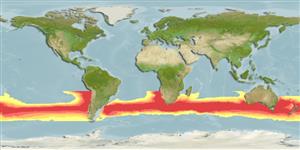>
Scombriformes (Mackerels) >
Scombridae (Mackerels, tunas, bonitos) > Gasterochismatinae
Etymology: Gasterochisma: Greek, gaster = stomach + Greek, chiasma = marked with the sign of "X" (Ref. 45335).
More on author: Richardson.
Environment: milieu / climate zone / depth range / distribution range
Ecologie
marien; oceanodroom (Ref. 51243); diepte 200 - ? m (Ref. 9563). Subtropical; 8°C - 15°C (Ref. 168); 19°S - 55°S, 180°W - 180°E (Ref. 168)
Circumglobal in southern temperate waters.
Grootte / Gewicht / Leeftijd
Maturity: Lm ? range ? - ? cm
Max length : 164 cm FL mannelijk / geslacht onbekend; (Ref. 168)
Korte beschrijving
Determinatiesleutels | Morfologie | Morfometrie
Dorsale stekels (totaal) : 17 - 18; Dorsale zachte stralen (totaal) : 9 - 12; Anale stekels: 0; Anale zachte stralen: 11 - 13; Wervels: 44. Pelvic fins enormous in juveniles, longer than head length. Pelvic fins fitting into a deep ventral groove at all sizes. Interpelvic process tiny and bifid. No anterior corselet. Swim bladder present with two anterior projections that extend into the back of the skull. The morphological adaptations required for maintaining high brain and retinal temperatures are discussed in Ref. 11221.
Occurs in deep oceanic waters (Ref. 9563), most abundant in waters of 8° to 10°C. Stomach contents of the specimen from north of the Hawaiian Archipelago include onychoteuthids, ommastrephid squid, vertebrae and fin rays from an unidentified fish, bird feathers and parasitic nematodes (Ref. 11006). Taken as longline by-catch by Japanese fishing for Thunnus maccoyii.
Levenscyclus en paargedrag
Maturiteit | Voortplanting | Paaien | Eieren | Fecunditeit | Larven
Collette, B.B. and C.E. Nauen, 1983. FAO Species Catalogue. Vol. 2. Scombrids of the world. An annotated and illustrated catalogue of tunas, mackerels, bonitos and related species known to date. Rome: FAO. FAO Fish. Synop. 125(2):137 p. (Ref. 168)
Status op de Rode Lijst van het IUCN (Ref. 130435: Version 2024-1)
Gevaar voor de mens
Harmless
Gebruik door de mens
Visserij: van minder commercieel belang; sportvis: ja
Tools
Speciale rapporten
Download XML
Internetbronnen
Estimates based on models
Preferred temperature (Ref.
123201): 10.2 - 15.9, mean 11.7 °C (based on 22 cells).
Fylogenetische diversiteitsindex (Ref.
82804): PD
50 = 1.0000 [Uniqueness, from 0.5 = low to 2.0 = high].
Bayesian length-weight: a=0.01122 (0.00514 - 0.02450), b=3.04 (2.87 - 3.21), in cm total length, based on all LWR estimates for this body shape (Ref.
93245).
Trofisch niveau (Ref.
69278): 4.4 ±0.57 se; based on food items.
Weerstandsvermogen (Ref.
120179): Gemiddeld, minimale populatieverdubbelingstijd 1,4-4,4 jaar (Preliminary K or Fecundity.).
Fishing Vulnerability (Ref.
59153): Very high vulnerability (90 of 100).
Nutrients (Ref.
124155): Calcium = 28.4 [15.9, 50.2] mg/100g; Iron = 1.3 [0.8, 2.2] mg/100g; Protein = 22.7 [20.5, 24.6] %; Omega3 = 0.397 [0.256, 0.622] g/100g; Selenium = 35.7 [20.8, 64.7] μg/100g; VitaminA = 11.5 [4.4, 31.5] μg/100g; Zinc = 0.443 [0.319, 0.627] mg/100g (wet weight); based on
nutrient studies.
